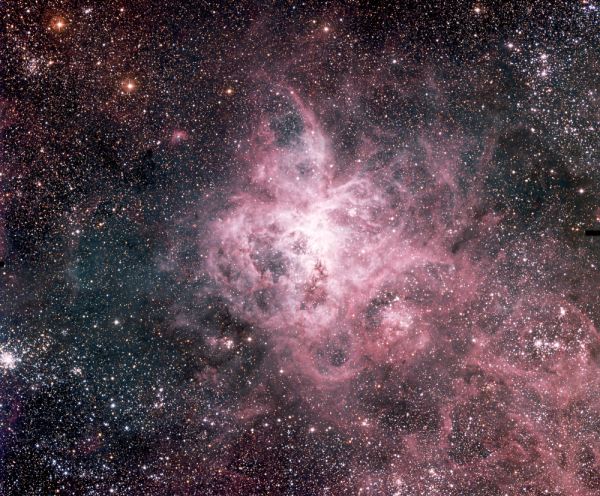Credit & Copyright: M. Schirmer, T. Erben, M. Lombardi
(IAEF Bonn),
European Southern Observatory
Explanation:
The
Tarantula Nebula is more than 1,000 light-years across -
a giant emission nebula within our neighboring galaxy
the Large Magellanic Cloud.
Inside this cosmic arachnid lies a central young cluster of massive
stars, cataloged as
R136, whose intense radiation and strong winds
have helped energize the nebular glow and shape the spidery filaments.
In this
impressive color mosaic
of images from the
Wide-Field Imager
camera on ESO's 2.2 meter telescope at La Silla Observatory, other
young star clusters can be seen still within the
nebula's grasp.
Also notable among the denizens
of the Tarantula zone are several
dark clouds
invading the nebula's outer limits as well as
the dense cluster
of stars NGC 2100 at the extreme left edge of the
picture.
The small but expanding remnant of
supernova 1987a, the closest supernova
in modern history,
lies just off the lower right corner of the field.
The rich mosaic's field of view covers an area on the sky
about the size of
the full moon in the southern
constellation Dorado.
1999 2000 2001 2002 2003 2004 2005 2006 2007 2008 2009 2010 2011 2012 2013 2014 2015 2016 2017 2018 2019 2020 2021 2022 2023 2024 2025 |
Январь Февраль Март Апрель Май Июнь Июль Август Сентябрь Октябрь Ноябрь Декабрь |
NASA Web Site Statements, Warnings, and Disclaimers
NASA Official: Jay Norris. Specific rights apply.
A service of: LHEA at NASA / GSFC
& Michigan Tech. U.
|
Публикации с ключевыми словами:
Tarantula Nebula - NGC 2070 - 30 Doradus - эмиссионная туманность - Большое Магелланово Облако - LMC
Публикации со словами: Tarantula Nebula - NGC 2070 - 30 Doradus - эмиссионная туманность - Большое Магелланово Облако - LMC | |
См. также:
Все публикации на ту же тему >> | |
